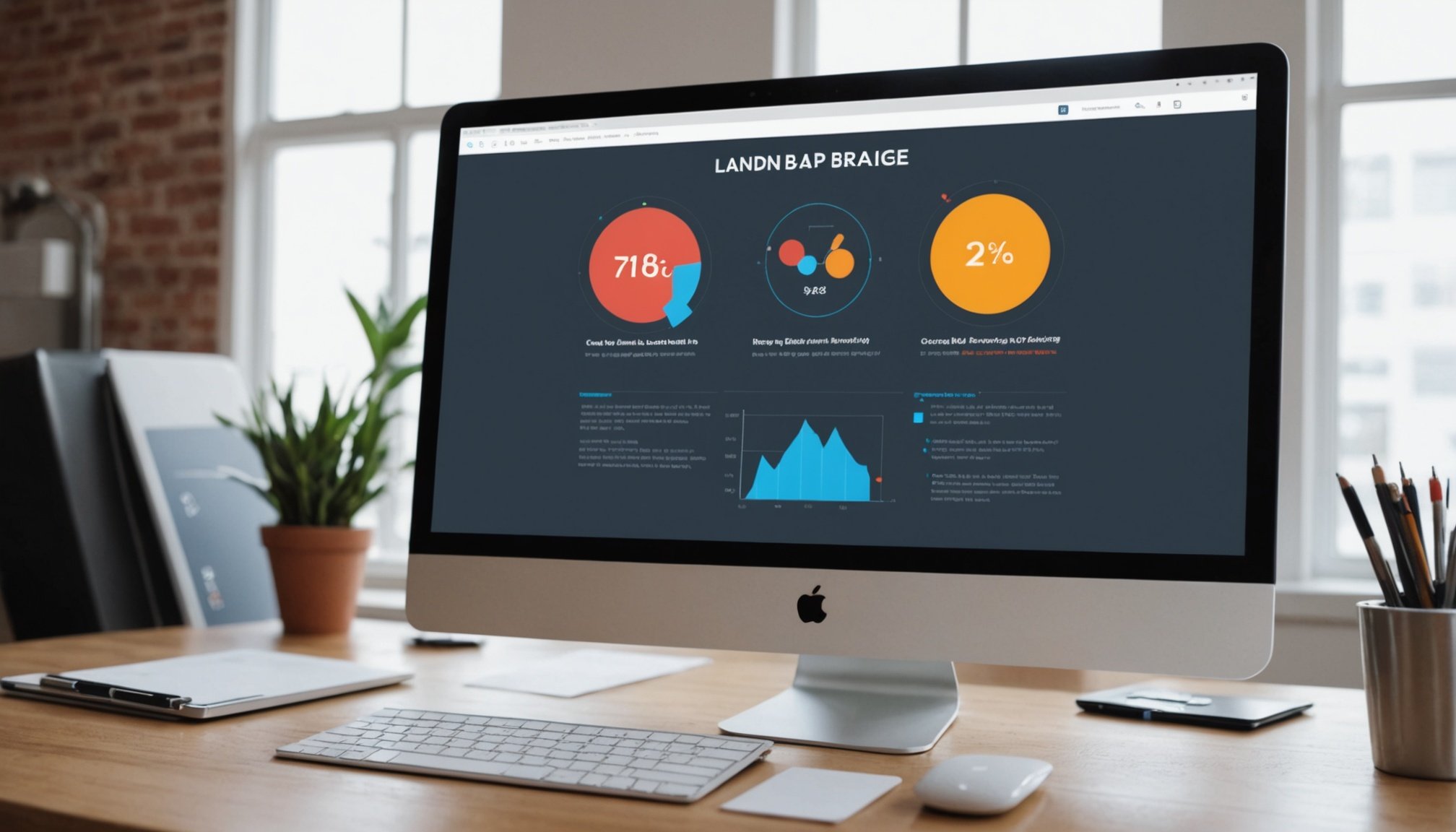Understanding A/B Testing
A/B testing, a cornerstone of conversion rate optimization, is crucial in the realm of digital marketing. It involves comparing two versions of a webpage to determine which one performs better regarding user engagement and conversion rates. The testing fundamentals of A/B testing are simple: by changing a single element on a webpage, you can measure the direct impact on user behaviour. This technique is essential for optimizing landing pages to boost conversions, thereby directly impacting business outcomes.
An often-overlooked aspect is the role A/B testing plays in eliminating guesswork in decision-making. It provides tangible evidence on which marketing strategies resonate most with your audience. However, common misconceptions about A/B testing can make it seem either too simplistic or too complex. One such misconception is the belief that A/B testing should produce quick results. In reality, effective A/B testing requires sufficient time and traffic to achieve statistical significance, ensuring that outcome data is reliable.
Topic to read : Top strategies for boosting website loading speed and enhancing user experience
Understanding A/B testing is imperative for marketers aiming to enhance their digital strategies. By systematically testing and iterating on components, it allows for continuous improvement, fostering a more engaging and conversion-optimized digital presence.
Understanding A/B Testing
A/B testing is a significant method in digital marketing, crucial for conversion rate optimization. It involves comparing two versions of a webpage or a product feature to determine which performs better, ultimately enhancing the effectiveness of landing pages. This process focuses on identifying user preferences and behaviours, thereby increasing the likelihood of conversions. By systematically altering elements such as headlines, images, or call-to-action buttons, marketers can understand what resonates best with their audience.
Also to discover : Essential elements for crafting an impactful mobile marketing strategy
Despite its value, common misconceptions about A/B testing often surface. Some believe it’s solely about making arbitrary changes, leading to confusion about its true purpose. However, effective A/B testing relies on understanding testing fundamentals and crafting data-driven hypotheses. It’s not merely about guessing but about making informed decisions based on real user interactions.
A/B testing’s role in landing page optimization cannot be overstated. By seamlessly integrating these tests into your digital strategy, you can continually refine your pages to meet user needs more effectively. The insights gained are indispensable, offering a clear path to improving user experience and boosting engagement metrics, which ultimately contribute to a higher conversion rate.
Types of A/B Tests
In digital marketing, understanding the various types of A/B tests can significantly enhance your testing strategies. These methodologies range from split testing to multivariate testing, each serving its unique purpose.
Classic A/B Testing
Classic A/B testing involves comparing two distinct versions of a webpage or element to evaluate which iterates better performance metrics. This approach is straightforward and best when you want to test a single variable to isolate its impact effectively.
Split URL Testing
Split URL testing, another form of A/B testing, differs by directing users to entirely different URLs. It’s particularly beneficial for testing page layout changes or redesigns, as it provides clear comparative data on visitor behaviour and engagement on two separate web pages.
Multivariate Testing
Unlike traditional A/B tests focusing on one variable, multivariate testing assesses multiple variables simultaneously. This method determines the optimal combination of elements on a page. By analysing various combinations, businesses can fine-tune more intricate aspects of a site, such as headlines, images, and call-to-action buttons.
Selecting the most suitable type of test depends on your business goals. Classic A/B testing is ideal for simplicity, while split URL and multivariate testing offer insights for more complex alterations. Evaluating objectives ensures tests are aligned with desired outcomes, providing valuable data for conversion rate optimization.
Best Practices for A/B Testing
Implementing A/B testing best practices is crucial to maximize effectiveness and derive actionable insights. Start with organizing and prioritizing tests by aligning them with strategic goals. This ensures that resources are focused on high-impact areas, fostering more meaningful results.
Engage in comprehensive testing guidelines by establishing clear, data-driven hypotheses. A successful hypothesis should be based on prior insights and target a precise element for testing. This clarity aids in attributing changes in conversion rates directly to tested variables.
Tracking the right metrics is another cornerstone. Consider key performance indicators (KPIs) like conversion rate, bounce rate, and average session duration. These metrics are instrumental in understanding user behaviour and gauging the effective strategies employed.
Be wary of common pitfalls. One major error is conducting tests without achieving statistical significance, leading to unreliable conclusions. Always ensure your sample size is large enough to validate findings.
By adhering to these guidelines, your A/B tests will not only improve conversion rates but also enhance overall digital strategy. Emphasizing precision in experimental design aids ongoing optimization efforts, leading to sustainable business growth.
Best Practices for A/B Testing
In the arena of A/B testing, adhering to best practices is pivotal for effective conversion rate optimization. Organizing and prioritizing tests can determine their success. Begin with a hypothesis anchored in user data and market research, as it sets a solid foundation for testing. Without this, testing strategies may flounder due to lack of direction.
Key metrics to track include conversion rates, time on page, and bounce rates. These provide a quantitative look at performance changes. Missteps, like running tests too briefly, can skew results and lead to erroneous conclusions.
Effective A/B testing requires well-structured experimental design. This means ensuring a sufficient sample size and test duration to achieve statistical significance. Avoid the pitfall of overcomplicating tests with too many variables; instead, keep it simple to isolate the impact of specific changes.
A/B testing is not just about quick wins—it’s about fostering a culture of ongoing improvement. By following stringent testing guidelines, teams can gain valuable insights that translate into better user experiences and enhanced conversion rate optimization. Adaptation based on test outcomes ensures growth and sustained success in optimizing digital marketing efforts.
Tools for A/B Testing
A/B testing tools play a crucial role in executing seamless testing strategies. They provide a framework for crafting hypotheses and conducting tests, ensuring that experiments are both efficient and insightful. Essential features to look for include user segmentation and real-time reporting, allowing for precise experimental design and immediate analysis of A/B testing outcomes.
Overview of Popular Tools
Several A/B testing tools stand out in the market for their robust functionalities. Optimizely and VWO are renowned for their user-friendly interfaces, enabling marketers to perform tests without extensive technical knowledge. Meanwhile, Google Optimize offers seamless integration with Google Analytics, facilitating in-depth data-driven decisions.
Features to Look for in A/B Testing Software
When selecting testing platforms, prioritize features such as multivariate testing capabilities, easy integration with existing systems, and reliable support services. These characteristics ensure smooth operation and timely resolution of any issues, enhancing the overall testing experience.
Integrating A/B Testing Tools with Other Marketing Strategies
Combining A/B testing with other marketing strategies provides a holistic view of user behaviours. By merging tools with analytics platforms, businesses can uncover invaluable insights, leading to more informed decision-making. Employing a seamless connection between platforms enhances conversion rate optimization efforts, ultimately refining digital marketing strategies.
Successful Case Studies
Exploring A/B testing success stories provides invaluable insights into optimizing digital strategies and achieving significant conversion improvements. Noteworthy case studies like those of Airbnb, Netflix, and Microsoft emphasize the profound impact of A/B testing when crafted with a meticulous approach.
Airbnb leveraged A/B testing to refine search filters and booking page elements, resulting in enhanced user engagement and higher booking rates. This highlights how focusing on user-centric design can drastically affect service usability and satisfaction.
Netflix frequently uses A/B tests to evaluate interface changes and content recommendations. By targeting user preferences, these tests have culminated in a personalized and appealing user experience, crucial for retaining subscribers in a competitive market.
Microsoft improved the style and layout of its landing pages through comprehensive A/B testing. This approach led to substantial increases in conversion rates, demonstrating the effectiveness of aesthetics and clarity in digital interfaces.
Each example elucidates the power of data-driven decisions. Successful outcomes are often characterized by a strong hypothesis, rigorous experimental design, and a focus on testing strategies that align with precise business goals. These elements foster reliable insights and drive substantial gains in user interaction and satisfaction.
Methodologies of A/B Testing
Understanding A/B testing methodologies is fundamental to mastering testing strategies. Each methodology allows marketers to explore different facets of user experience, enhancing the precision of the experimental design. At the core of effective testing is the formulation of solid hypotheses. A well-crafted hypothesis acts as a roadmap, guiding the direction and focus of your test. It should be specific, measurable, and based on previous user data or behavioural insights.
Different methodologies utilized in A/B testing include:
-
Sequential Testing: This involves running tests in a sequence, using the results of one to inform another, ensuring a clear and structured approach.
-
Time-Based Testing: Testing over different times or periods helps evaluate variables that might be affected by seasonal behaviours.
Steps to designing effective A/B tests start with setting clear objectives. Once you have a defined hypothesis, create variations to be tested. Ensure your test is large enough to reach statistical significance, providing reliable data. Run the tests concurrently to minimize external influences, and use robust analytics to capture measurable metrics. Each step is essential in refining your strategies and leveraging A/B testing to drive conversion rate optimization.
Analyzing A/B Test Results
Analyzing A/B test results is crucial for making informed, data-driven decisions. To accurately interpret these results, understanding the methods of analysis is paramount. Initially, focus on metrics like conversion rate changes, engagement levels, and revenue shifts. By tracking these, one can gauge the effectiveness of A/B testing.
Statistical significance plays a vital role in validating results. Achieving a statistically significant outcome ensures that the observed changes are not due to chance but reflect actual effects. This reinforces the reliability of the experimental design and the subsequent insights.
Converting data into actionable insights requires a meticulous approach. Start by identifying which variations performed best and analyze user behaviour changes. Consider external factors that might have influenced results, like seasonal trends or concurrent marketing activities. A comprehensive understanding paves the way for strategic adaptations.
Utilize A/B testing methodologies to detect patterns from your data. Segmentation provides clarity, as it uncovers how different user groups respond to changes. This enables tailored strategies that better align with audience preferences. Remember, precise test analysis is the cornerstone of effective conversion rate optimization, ensuring continuous improvement in achieving marketing goals.
Analyzing A/B Test Results
A/B test analysis is crucial to converting test results into actionable insights. First, examine data for patterns or shifts in user behaviour linked to changes in the tested elements. Interpreting results requires a firm grasp of statistical significance. This confirms whether observed differences are due to the changes implemented or are just random variances. A statistically significant outcome implies confidence that the result reflects true behaviour changes, not chance.
The next step involves using these insights to make data-driven decisions. By understanding the implications of results, businesses can refine website elements or marketing strategies to enhance conversion rate optimization. Regularly revisit and analyse existing data, which ensures continued alignment with evolving consumer preferences and market trends.
Moreover, A/B test analysis should feed into an iterative testing framework, supporting a cycle of ongoing assessments and adjustments. This process demands patience and precision but offers the potential for incremental improvements that result in substantial gains over time. Companies that incorporate consistent analysis and learning into their strategy can adapt more seamlessly, fostering a dynamic and optimised digital presence.
Continuous Optimization Cycle
In the realm of conversion rate optimization, embracing an iterative testing approach is crucial. A/B testing should be viewed as a cyclical process, constantly refining strategies based on outcomes. This cycle involves designing tests, analyzing results, and then adapting based on insights gained, enabling ongoing enhancement of digital experiences.
The core of a successful iterative testing process lies in understanding that modifying strategies is not a one-time event. Instead, it requires continuous monitoring and adjustments. Marketers should always be ready to ask new questions, execute fresh tests, and implement improvements based on data-driven insights. This ongoing refinement helps maintain relevance in shifting market conditions and user needs.
Building a culture of ongoing improvement in landing page optimization is essential. By fostering this mindset, businesses can ensure their digital assets are continuously aligned with user expectations and demands. Regularly testing various elements, from content to design, allows businesses to discover what resonates with audiences and optimise accordingly.
Ultimately, this continuous optimization cycle supports active adaptation, resulting in superior user engagement and increased conversion rates. Organizations that integrate these adaptive strategies thrive by maintaining competitive edge and achieving long-term success in their marketing efforts.
Continuous Optimization Cycle
Understanding the continuous optimization cycle in A/B testing is vital for fostering ongoing improvements in user experience. The cyclical nature of A/B testing involves iterative testing and refinement of strategies based on previous outcomes. This approach ensures that any landing page changes reflect current user behaviour patterns and preferences, enhancing conversion rate optimization.
A successful cycle begins by analysing data from past experiments to form new hypotheses. This data-driven approach guides the development of subsequent tests, targeting specific areas for improvement. The process is iterative, demanding regular adjustments to stay aligned with evolving market trends and user expectations.
Building a culture of continuous improvement is crucial within organizations. Encouraging teams to view landing page optimization as an ongoing journey rather than a one-time task fosters innovation and adaptability. It involves monitoring test results continuously, learning from each cycle, and applying insights to new tests.
The most effective strategies emerge from consistently reviewing and adapting based on feedback and results. This not only bolsters the effectiveness of digital marketing efforts but also solidifies the connection between the brand and its audience, ultimately driving higher engagement and conversion rates.
Analyzing A/B Test Results
Analyzing A/B test results effectively is crucial for making informed, data-driven decisions. Initially, focus on key metrics like conversion rates and user engagement to determine which variation performs better. When asked, “How do you ensure your results aren’t just by chance?” the Stanford Question Answering Dataset (SQuAD) method suggests checking for statistical significance. Achieving statistical significance indicates that observed changes are likely due to the test variations rather than random fluctuations.
Upon interpreting results, consider how variations influenced user behaviour. Did they increase conversions or enhance user engagement metrics? Use these insights to refine website elements or marketing strategies, aligning them with user preferences for better conversion rate optimization.
Next, examine external factors like market trends or promotional events that might have impacted the outcomes. Incorporate these considerations into your interpretation framework to gain a comprehensive view. Employ segmentation to discern how specific user groups responded differently, allowing for tailored strategies that cater to diverse audiences.
Leveraging these steps not only validates the effectiveness of your A/B testing methodologies but also equips your team with actionable insights, driving sustained growth and improved performance in digital marketing efforts.
Tools for A/B Testing
A/B testing tools are integral for implementing effective testing strategies. They streamline the process, ensuring precise experimentation and reliable results.
Overview of Popular Tools
Renowned A/B testing platforms like Optimizely and VWO stand out for their intuitive interfaces and powerful utilities, making experimentation accessible even without extensive programming knowledge. Meanwhile, Google Optimize offers seamless integration with Google Analytics, enhancing data-driven decision-making capabilities. Each tool provides unique strengths that suit different needs in conversion rate optimization.
Features to Look for in A/B Testing Software
When selecting testing software, prioritize features like real-time analytics, user segmentation, and multivariate testing capabilities. These elements enable detailed data analysis and more targeted testing processes. Advanced reporting tools also allow businesses to swiftly interpret results and pivot strategies efficiently.
Integrating A/B Testing Tools with Other Marketing Strategies
Combining A/B testing platforms with your broader marketing toolkit offers a comprehensive view of user interactions. Leverage analytics tools to synthesize A/B test data, refining other campaigns based on insights derived. This holistic integration not only bolsters conversion rate optimization but also provides actionable insights, driving smarter marketing solutions tailored to evolving consumer behaviour.










